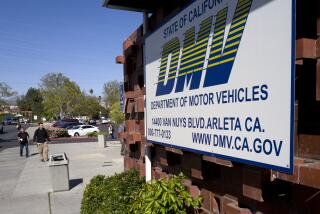Seniors Aren’t the Only Hazardous Drivers on the Road
Clamping down on elderly drivers is an obvious move, and it’s tragic that it took a trail of bodies at the Santa Monica Farmers’ Market to get the conversation going again.
George Russell Weller, 86, says he hit the gas instead of the brakes, an explanation that’s understandable for a half-block, but not the 2 1/2-block path of destruction he wrought. So yes, let’s have driving tests for motorists 75 and above, and let’s revoke the licenses of those who’ve lost their vision or their wits.
But all of a sudden it looks like open season on anyone with white hair and spectacles, as if they’re the only drivers creating a hazard out there. Boomers are supposed to snatch the keys away when their parents aren’t looking, or sit them down for a driver’s ed refresher. Fine, but here’s a question:
The last time someone came barreling down the road, weaving in and out of traffic, cutting you off and putting the lives of pedestrians and other drivers in danger, did he look like he was on his way to the senior center for a game of shuffleboard?
“Statistics show that the most dangerous group is young drivers 16 to 21,” says Tom Marshall, a spokesman for the California Highway Patrol. “Elderly drivers are the second most dangerous group.”
Older drivers generally create hazards by driving too slowly, not too fast.
“The fast drivers -- the ones cutting in and out of traffic -- are younger,” says Lt. Maryann Farmar of the CHP.
But speed isn’t the only problem, and the market on bad driving has not been cornered by either the young or the elderly. If we’re going to start taking people’s keys away, let’s not do a halfhearted job.
Now this is just one man’s perspective, and maybe I’m sensitized by a recent development in my life. I have an infant daughter, and putting her in the car for the ride home from the hospital last week, I was suddenly hyper-aware of all the maniacs on the road.
The lane hogs, the tailgaters and the NASCAR wannabes.
Do you recall a time when more drivers ignored speed limits with such impunity?
Do you recall a time when there was less basic etiquette and more rudeness on the road?
Every other vehicle is big enough to be used in the next war, obstructing the view of anyone who isn’t towering above it all in a Ford Extinction. And at a certain point in this evolution of self-indulgence, everyone suddenly became so important they had to be on a cell phone while shopping at the supermarket, sitting at a cafe, and, most importantly, while driving.
Those are the keys to take away first -- the keys of the driver who’s straddling two lanes and is unaware of a single other vehicle on the road because he/she is on the phone. And you know it’s one of those conversations that begins, “So what’d you guys do last night?”
Unfortunately, good drivers have lost something that was once a sacred right. They have lost the simple pleasure of shaking a fist, or employing an even more satisfying gesture, at another motorist. It could cost you your life.
“It seems like 20 years ago, people were more courteous about everything,” says Lt. Farmar. “Opening a door, signaling when turning, everything. Now everyone’s in too big a rush, and no one signals. Shaking your fist at them is not a good idea.”
Farmar says the CHP has the same number of officers, about 7,000, that it had 30 years ago when California’s population was roughly half what it is now. Maybe that’s one reason drivers take risks. In Los Angeles, where the LAPD has its own shortage of officers, speeding is the crime almost everyone commits and gets away with. I know I have.
As I got closer to home with my newborn, I came upon one of those big scoreboard contraptions that tells you how fast you’re going as a way of discouraging speeding.
I was going 5 mph above the limit.
It won’t happen again.
*
Steve Lopez writes Sunday, Wednesday and Friday. Reach him at [email protected].
More to Read
Sign up for Essential California
The most important California stories and recommendations in your inbox every morning.
You may occasionally receive promotional content from the Los Angeles Times.











